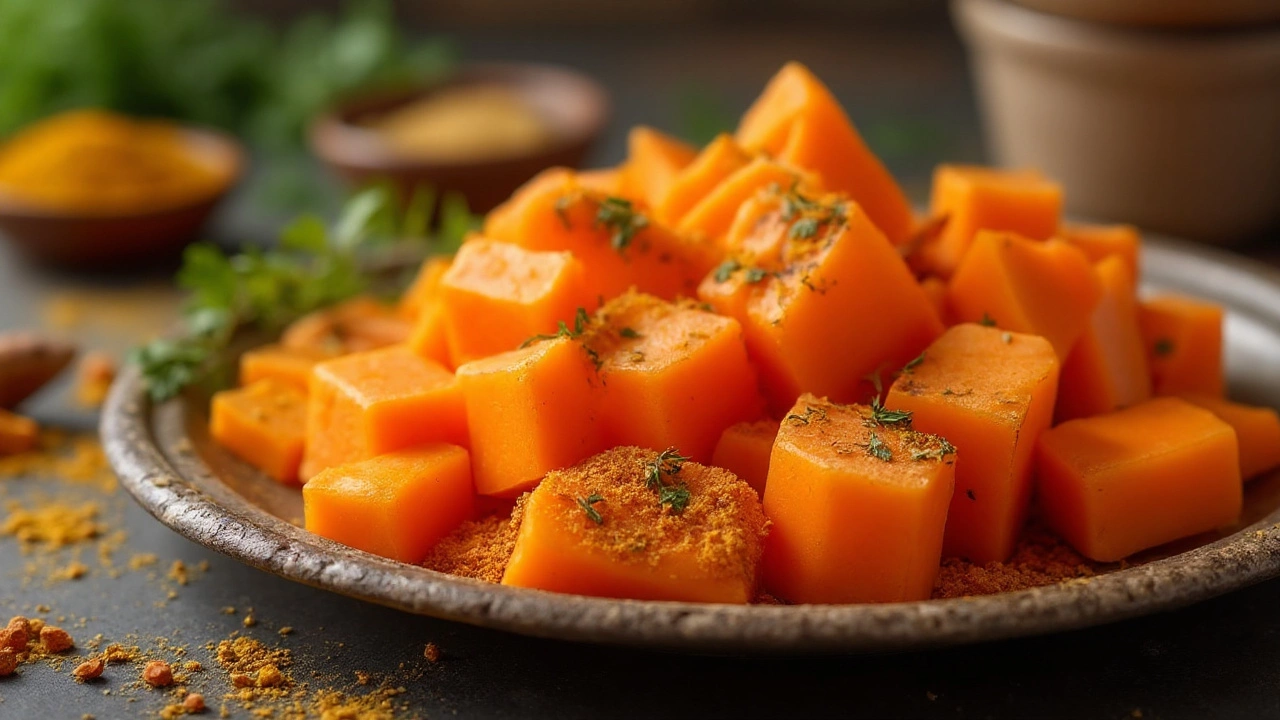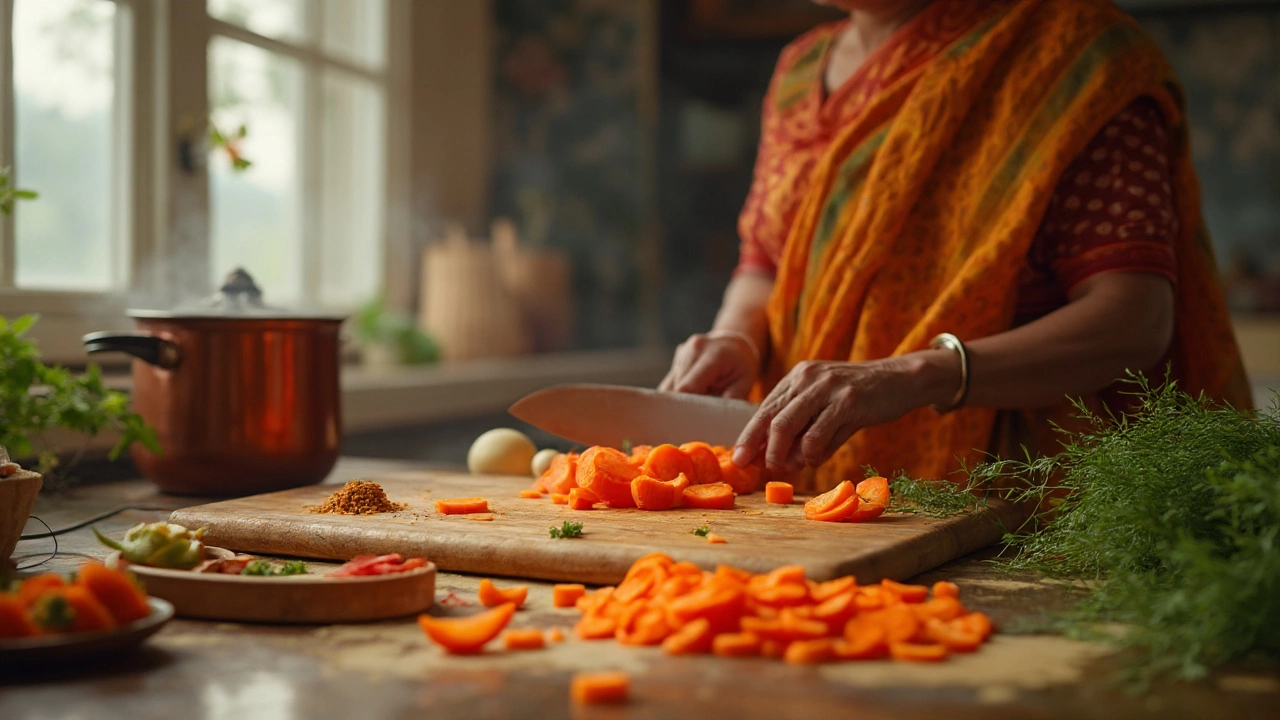Ever sat down for a cozy bowl of curry and bit into a chunk of carrot that was either rock-hard or mushy beyond recognition? That split-second of disappointment is such a letdown, especially when you know the whole curry could be so much better. Believe it or not, the way you cut your carrots actually makes all the difference—both in how the veggie cooks and the final mouthfeel of your curry. Some days, you want the carrots to almost melt into the gravy and others, you want that bit of bite. Little kitchen choices like these turn simple home cooking into something friends rave about. Ready to master cutting carrots for curries that never let you down?
The Impact of Carrot Size and Shape in Curry
Carrots aren’t just another veg in your curry—they play a starring role in soaking up spices and adding their subtle sweetness to the dish. The size and shape of your carrot pieces decide how quickly they cook and whether they’ll hold up or vanish into the sauce. Slice too thin and you’re fighting carrot mush. Go too chunky and you might as well be chewing raw veg at the dinner table. Curries rely on balance, and it starts before you even switch on the stove.
If you ask seasoned cooks from India or even grandmother’s here in Sydney’s bustling suburbs, they’ll likely say the perfect curry carrot should be just soft enough to bite, but never falling apart. That means the classic round slices aren’t always ideal. Too thick? They refuse to cook. Too thin? They get lost in the sauce. Instead, the diagonal cut, sometimes called the "Asian bias cut," ups their surface area so they soak in spices better, look fancier, and cook evenly. You end up with pieces that look pro and actually taste like they belong in the curry, not something tossed in as an afterthought.
Let’s talk about the French "julienne" and "batonnet" styles. While these are popular in Western kitchens, thin matchsticks and thick rods aren’t usually the best for curries. Julienne carrots can disappear fast in a slow-cooked curry, and chunky batons hold up too much, almost making things awkward to eat with a spoon and not a fork. The best size seems to be slices about 5mm thick (think about as thick as two $2 coins stacked), especially when cut on a slant, or thicker half-moons if you want a rustic touch. The nice part? Both styles give a curry on the table that looks beautiful and feels like someone cared enough to get the little details right.
There’s also a practical point to sizing: smaller pieces pick up more of the curry’s flavor, while larger ones offer sweetness and a burst of carrot essence with each bite. The dish you’re making matters here. For something like a South Indian sambar, you might want chunkier, stick-cut carrots that hold their shape in the soupy base. In a rich North Indian curry where deep flavors and creamy sauces shine, those angled slices will soak everything up and truly belong. Ask any seasoned home cook—once you start paying attention to how you cut your roots, you’ll never go back.
Essential Tools for Precision Cutting
All you really need to start is a sharp chef’s knife and a sturdy chopping board. Yeah, technical talk about Japanese knives and high-carbon steel is fun, but unless you’re a knife nerd, don’t stress. Just make sure the knife can cut through a carrot without slipping. A dull knife not only smashes up your veg but is actually more dangerous than a sharp one. That quick slip when you force it? Total kitchen nightmare.
If you’ve ever watched someone on YouTube glide through a carrot like it’s butter, it’s not magic. They probably just keep their knife sharp—give yours a quick flick on a steel or a whetstone every so often. For the board, plastic or hardwood are best; glass boards blunt your knife so fast, it’s not worth the fancy look.
Some home cooks swear by vegetable peelers and even mandolins for their carrots. These make lightning-quick work of slicing, but honestly, you don’t need to go out and buy a mandolin unless you’re really into fine julienne. For thin curry slices, a knife works just fine. One smart tip? Cut off a small strip from one side of the carrot so it sits flat before slicing. It means no more wobbling around, making things a whole lot safer (and easier, especially if you’re slicing five carrots at a go for a family curry). If you’ve got little kids helping, spring for a safety peeler or keep them on the carrot-washing and handing-you-the-next-one detail.
Ever seen those crinkle cutters? While they make carrots look cute, the uneven edges sometimes mess with how quickly the carrot cooks. Stick to straight or angled slices if you care about even results. For curries that cook in under 30 minutes, thin slices are the way to go. For long-simmered curries, like those cooked in slow cookers or big stovetop pots, chunkier bits keep their bite and add a rustic feel to the meal. Taste and texture are a package deal, all thanks to the humble knife and a little know-how.

Step-By-Step: Cutting Carrots for Different Curry Styles
So, you’ve got your carrots, a sharp knife, and you’re ready to go. Let’s break down how to cut carrots for curries, from everyday family meals to dinner party showstoppers. It’s not just about appearance; it’s how the carrots soak up flavor and hold their own in the mix of spices, potatoes, and tender meats or legumes.
- Wash and Peel: Even in Australia, carrots can come coated with soil and grit. A good scrub under running water, or a quick go with a vegetable peeler, does wonders for flavor and hygiene. Peel if you want a more tender texture, or leave the skin for rustic, earthy flavor (it’s packed with nutrients).
- Stabilize: Cut a thin slice off one side so the carrot doesn’t roll. A wobbly veg is an accident waiting to happen.
- Choose Your Cut:
- Diagonal Slices (The Curry Classic): Hold the carrot at a 45-degree angle and slice pieces about 5mm thick. These wide, tilted discs cook quickly and absorb spices. Perfect for fast-cooking chicken or paneer curries.
- Half Moons: Slice the carrot lengthwise in half, then cut into semi-circles about 5-6mm thick. This gives a chunky but manageable size for saucy curries and stews.
- Chunky Sticks: For slow-cooked curries like sambar, cut the carrot into sections 4-5cm long, then slice each piece lengthwise into chunky sticks. They keep their shape but soften easily after soaking awhile in simmering broth.
- Small Cubes: If you want the carrots to nearly melt into the sauce (think dal-based curries), slice lengthwise into planks, cut planks into strips, and make cubes no larger than a fingernail. These cook quickly and blend into the masala base.
- Consistency Matters: Try to keep all the pieces roughly the same size no matter which cut you use. This means everything cooks evenly, so you’re not left picking out raw bits or carrot mush.
- When to Add Carrots: For quick curries, add the carrots early—this gives them time to soak up flavor. In slow-simmered dishes or stews, toss them in after your main spices and aromatics are done frying so they soak up all those tasty juices.
A little calorie bonus here: carrots are low in calories (about 41 per 100g) but big in vitamin A and fiber—a nice little perk for anyone aiming for a healthy twist on old-school curries.
Tips, Tricks, and Mistakes to Avoid
No one’s perfect in the kitchen, and carrots can turn on you with just one dull blade or distracted moment. Want your curry to stand out? Start by avoiding some classic carrot mistakes.
- Don’t Overcrowd the Pan: Too many carrot pieces touching in the pot means they steam instead of frying, leading to blandness and mush. Work in batches if needed.
- Resist Pre-Cutting Too Early: Carrots dry out fast. If you chop them too far ahead, they start to dry up and lose sweetness. Chop just before cooking or keep cut carrots in cold water (but don’t forget to drain before adding to the pan or you’ll splash hot oil everywhere—voice of experience here!).
- Use the Right Oil and Heat: Heavy oils like coconut or ghee bring out carrot sweetness. Medium-high heat at the start gets those caramel edges, then turn it down for simmering.
- Don’t Forget the Aromatics: Carrots are like sponges—they pull in all the flavor from garlic, ginger, and spices. Always fry those first before adding the carrots.
- Add Some Acid: A squeeze of lemon or splash of vinegar at the end brings out the best in carrots and livens up the entire curry.
- Try New Cuts: Got batch-cooking fatigue? Mix things up with half-moons one week, chunky cubes the next. Your eyes (and tastebuds) won’t get bored.
- Leftover Transformation: If you overcook the carrots, don’t sweat—blend them into the sauce for a creamy texture. Waste not, want not!
It sounds simple—how hard can chopping up a few carrots be? But honestly, paying a little more attention here sets the tone for your whole curry. And when someone says, “Wow, the carrots taste amazing,” you’ll know why. That sharp knife, the right cut, and a quick stir at the perfect moment—these things are the secret spice in any good home cook’s toolkit. Next time you’re at the markets or prepping for a family meal, give those carrots the attention they deserve. Your curry—and your reputation—are worth it.
